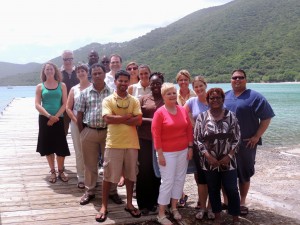
Resource managers are faced with environmental changes that threaten the health and vitality of coral reef ecosystems as a result of expanding coastal development, tourism and new industries in many Caribbean nations. To assist coral reef resource managers in their mitigation and conservation efforts, NCCOS, through the Coral Disease and Health Consortium with funding support from the NOAA Coral Reef Conservation Program, hosted a training workshop in the U.S. Virgin Islands on Practical Methods for Conducting Threat Assessments for Reef Managers, June 4–7.
Participants from Bahamas, Aruba, Belize, Cayman Islands, Antigua & Barbuda, St. Eustatius, Honduras, British Virgin Islands, Grenada and the U.S. National Park Service received instruction and advice on risk assessment methods and new scientific methods and tools to help them prioritize potential impacts from human activities, and generate data to justify and support management actions especially when availability of funds, expertise, or time may be a limiting factor.
Workshop attendees also gained experience testing the toxic effects of sediment pore waters on sea urchin development, a first step in the determination of the toxic biological characteristics of a particular site as well as the associated degree of toxicity—a test easily transferable to different geographic locations. Data from these and similar tests can be modeled for environmental risk evaluation purposes and establishing screening and action options. Armed with this information, managers can then develop mitigation strategies to reduce the impact of specific human activities and pollutants.
Mitigation actions can take on many different forms ranging from educational campaigns, rotating usage of a reef system, implementing innovative green technologies for waste management to regulatory actions.
Haereticus Environmental Laboratory provided in-kind support by teaching the classroom and laboratory courses at the University of the Virgin Islands in St. Thomas. Field activities and environmental sample collections were conducted at Hawksnest Bay, St. John.
